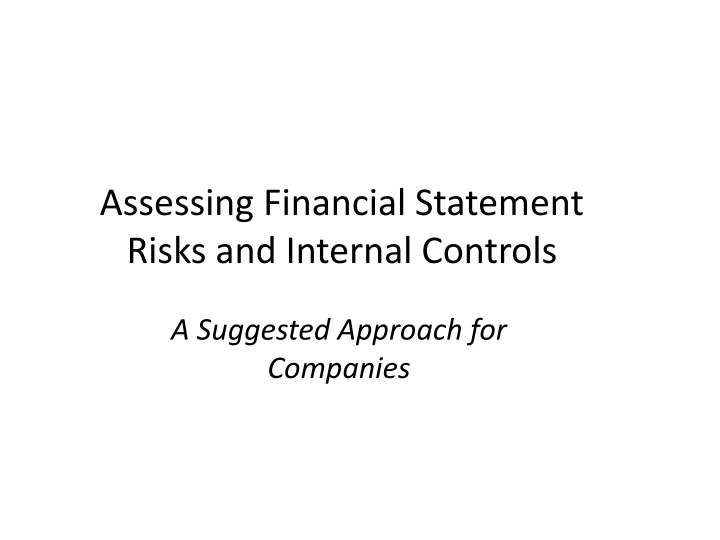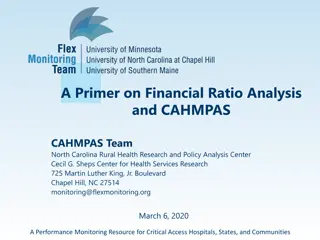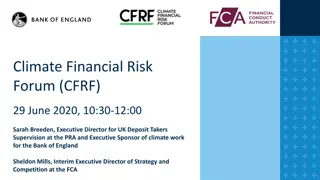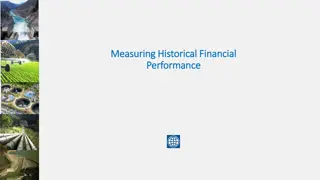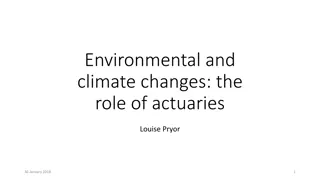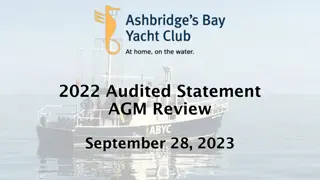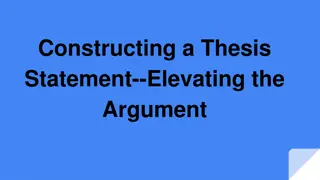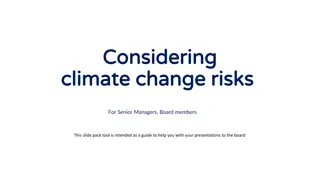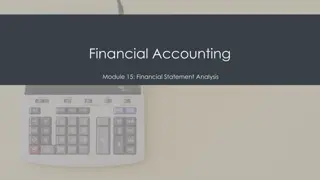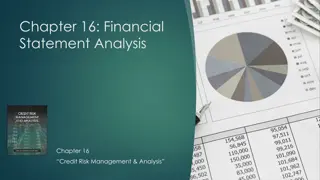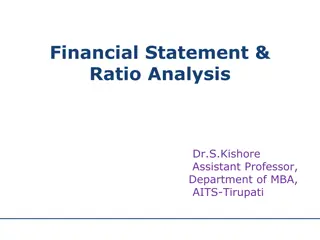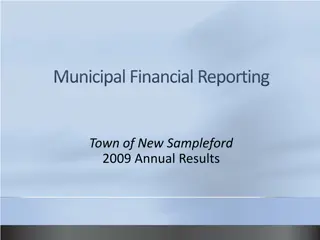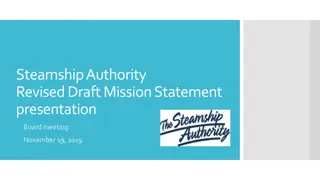Assessing Financial Statement Risks
This presentation delves into the identification and understanding of financial statement risks, internal control components, and key controls. It outlines reasons for assessing risks, examples of potential risks, and the importance of proper controls to mitigate these risks effectively.
Download Presentation

Please find below an Image/Link to download the presentation.
The content on the website is provided AS IS for your information and personal use only. It may not be sold, licensed, or shared on other websites without obtaining consent from the author.If you encounter any issues during the download, it is possible that the publisher has removed the file from their server.
You are allowed to download the files provided on this website for personal or commercial use, subject to the condition that they are used lawfully. All files are the property of their respective owners.
The content on the website is provided AS IS for your information and personal use only. It may not be sold, licensed, or shared on other websites without obtaining consent from the author.
E N D
Presentation Transcript
Assessing Financial Statement Risks and Internal Controls A Suggested Approach for Companies
Overview This presentation describes: Financial statement risks Reasons for identifying risks Examples and sources of risks Internal control components, control objectives, and key controls An approach for Identifying financial statement risks Assessing whether controls are adequate to mitigate the risks
Reasons for This Presentation To assist you in fulfilling your responsibilities for financial reporting To assist our firm in meeting professional requirements when performing your audit To help minimize your audit fees
What are Financial Statement Risks? Risks that affect the achievement of financial reporting objectives Conditions or indications that something could go wrong in the financial statements May relate to error or fraud May be pervasive to the financial statements or related to specific transactions, accounts, or disclosures
Why Identify and Understand Risks? Risk assessment is a key component of internal control Identifies what could go wrong in the financial statements Allows an evaluation of the likelihood and magnitude of potential misstatements Provides a foundation for assessing whether controls are properly designed and implemented
Considering Financial Statement Assertions Existence or occurrence Completeness Rights or obligations Valuation or allocation Accuracy or classification Cutoff
Examples of Risks Risk Indicator Inventory is highly liquid Financial Statement Risk Overstatement of inventory due to theft (Existence) Inventory cost accounting method is highly complex and subjective Overstatement or understatement of inventory due to improper cost accounting (Valuation) Understatement of the allowance for doubtful accounts (Valuation) Key customers are concentrated in an industry facing economic downturn The company is facing a number of lawsuits by customers Failure to disclose contingent liabilities (Completeness)
Possible Sources of Risk Structure, ownership, governance, and related parties Industry, regulatory, and other external factors The nature of the company, for example: Revenue sources Types of products, services, and markets Nature of assets, liabilities, expenses, investments, and financing Significant or unusual transactions Accounting policies Uses of the financial statements Information technology, including general controls
Possible Sources of Risk (Continued) Objectives and strategies Key performance measures Going concern issues Potential fraud Incentives/pressures Opportunities Attitudes/rationalizations
Internal Control Process employed by the company to provide reasonable assurance of achieving financial reporting objectives Consists of five interrelated components To be effective, all components should be present and functioning and operating together Applies to all companies both small and large Helps prevent, or detect and correct, misstatements resulting from risks
Five Components of Internal Control Control Environment Risk Assessment Information and Communication Monitoring Control Activities
Control Objectives, Principles, and Key Controls A control objective states the purpose of a control Principles represent the fundamental concepts associated with each component of internal control Controls are effectively designed if they achieve the objective/principle Key controls are those that are most important in achieving the objective
Control Environment Principles The entity demonstrates a commitment to integrity and ethical values The board of directors demonstrates independence from management in exercising oversight of the development and performance of internal control over financial reporting With board oversight, management establishes structures, reporting lines, and appropriate authorities and responsibilities to achieve financial reporting objectives The entity demonstrates a commitment to attract, develop, and retain competent individuals in alignment with financial reporting objectives The entity holds individuals accountable for their internal control responsibilities
Control Environment Examples Principle Control Example A process exists by which those charged with governance are made aware of key developments that may affect financial reporting The entity demonstrates a commitment to integrity and ethical values The board of directors demonstrates independence from management in exercising oversight of the development and performance of internal control over financial reporting With board oversight, management established structures, reporting lines, and appropriate authorities and responsibilities to achieve financial reporting objectives The board of directors is sufficiently independent of management so that necessary questions are raised Management periodically evaluates the entity s organizational structure and makes necessary changes based on changes in the business and/or industry
Control Environment Examples (Continued) Principle Control Example Employee recruitment and retention practices for key financial positions are guided by principles of integrity and by the necessary competencies associated with the positions Employees are empowered to correct problems or implement improvements in their assigned processes The entity demonstrates a commitment to attract, develop, and retain competent individuals in alignment with financial reporting The entity holds individuals accountable for their internal control responsibilities
Risk Assessment Principles The entity specifies objectives with sufficient clarity to enable the identification and assessment of risks relating to financial reporting objectives The entity identifies risks to achieving its objectives and analyzes risks to determine how the risks should be managed The entity considers the potential for fraud in assessing risks to the achievement of financial reporting objectives The entity identifies and assesses changes that could significantly impact the system of internal control
Risk Assessment Examples Principle The entity specifies objectives with sufficient clarity to enable the identification and assessment of risks relating to financial reporting objectives The entity identifies risks to achieving its objectives and analyzes risks to determine how the risks should be managed Control Example Management identifies risks related to laws or regulations that may affect financial reporting Periodic reviews are performed to, among other things, anticipate and identify routine events or activities that may affect the entity s ability to achieve its objectives The entity s assessment of fraud risk considers incentives and pressures, attitudes and rationalizations, as well as the opportunity to commit fraud Management communicates the risk assessment and changes in the business environment to all appropriate employees The entity considers the potential for fraud in assessing risks to the achievement of financial reporting objectives The entity identifies and assesses changes that could significantly impact the system of internal control
Information and Communication Principles Information: The entity obtains or generates and uses relevant, quality information to support the functioning of internal control over financial reporting
Information and Communication Principles (Continued) Communication: The entity internally communicates information, including objectives and responsibilities for internal control, necessary to support the functioning of internal control over financial reporting The entity communicates with external parties regarding matters affecting the functioning of internal control
Information Examples Principle Control Example The entity obtains or generates and uses relevant, quality information to support the functioning of internal control over financial reporting Relevant operating information is used to develop accounting and financial information and whether it serves as a basis for reliable financial reporting, including the basis for accounting estimates
Communication Examples Principle Control Example The entity internally communicates information, including objectives and responsibilities for internal control, to support the functioning of internal control over financial reporting The entity communicates with external parties regarding matters affecting the functioning of internal control Management has developed communication approaches that specify individual responsibilities in dealing with inappropriate behavior There is a process for tracking communications from customers, vendors, regulators, and other external parties
Monitoring Principles The entity selects, develops, and performs ongoing and/or separate evaluations to determine whether the components of internal control are present and functioning The entity evaluates and communicates internal control deficiencies in a timely manner to those parties responsible for taking corrective action, including senior management and the board of directors, as appropriate
Monitoring Examples Principle Control Example The entity selects, develops, and performs ongoing and/or separate evaluations to determine whether the components of internal control are present and functioning The entity evaluates and communicates internal control deficiencies in a timely manner to those parties responsible for taking corrective action, including senior management and board of directors, as appropriate Management s ongoing monitoring serves as a primary indicator of both control design and operating effectiveness and of risk conditions Findings of an internal control deficiency are reported to (1) the appropriate person who is in the position to take corrective actions and, if applicable, (2) at least one level of management above that person
Control Activities Principles The entity selects and develops activities that contribute to the mitigation of risks to the achievement of financial reporting objectives to acceptable levels. The entity selects and develops general control activities over technology to support the achievement of financial reporting objectives. The entity deploys control activities through policies and procedures that put policies into action.
Control Activities Examples Principle Control Example The company s control activities include periodic inventory observations and reconciliations to the general ledger The entity selects and develops activities that contribute to the mitigation of risks to the achievement of financial reporting objectives to acceptable levels The entity selects and develops general control activities over technology to support the achievement of financial reporting objectives The entity deploys control activities through policies and procedures that put policies into action. The IT general controls include periodic backups of databases and operating systems, including periodically testing for recoverability The company has defined policies and procedures regarding confidentiality of databases included in the system security.
Types of Control Activities Performance reviews Information processing controls Physical controls Segregation of duties Accountability
Control Activities Objectives Processing Cash Receipts Cash receipts information is valid and processed only once (E/O, R/O) Cash receipts are appropriately safeguarded (E/O) Cash received is posted in the proper period (CO) Cash receipts information is recorded in the correct account (A/CL) Recorded cash receipt amounts are correct (A/CL) All cash receipts are recorded (C) Foreign currency cash received is correctly valued (V)
Control Activities Examples Processing Cash Receipts Lockbox receipts are compared to customer remittances (E/O, C, R/O, A/CL, CO) Cash receipts are reconciled to general ledger postings daily (E/O, V, R/O, CO) Bank reconciliations are prepared and reviewed in a timely manner (E/O, C, V, R/O, A/CL, CO)
Putting It All Together: A Process for Identifying Risks and Assessing Controls Consider the aspects of the company that are sources of risk Gather information that indicates potential risks Accumulate and synthesize the information to identify risks Identify key controls that address the risks by focusing on control objectives Assess whether controls are properly designed and implemented to achieve the objectives Identify gaps and prioritize deficiencies for improvement
A Practical Approach to Reviewing Internal Control Supporting tools to help you assess entity- level controls: Complete (or update) a narrative describing your entity-level controls using Understanding the Design and Implementation of Internal Control Supplement the documentation by completing the related Entity-level Control Form
A Practical Approach to Reviewing Internal Control (Continued) Supporting tools to help you assess activity- level controls: Complete (or update) a narrative describing your activity-level controls using Financial Reporting System Documentation Form Financial Close and Reporting, Significant Transaction Classes Supplement the documentation by completing the related Control Activities Form
A Practical Approach to Reviewing Internal Control (continued) Evaluate controls to determine if: Key controls are present to achieve control objectives/principles and address relevant financial statement risks Controls are properly designed to prevent, or detect and correct, misstatements Controls are in place to address all identified risks
A Practical Approach to Reviewing Internal Control (continued) If controls are missing or improperly designed, determine: Whether another control could mitigate the deficiency The likelihood and magnitude of potential errors The pervasiveness of potential errors The priority for corrective action
Conclusion Risk Assessment: A key component of internal control Allows the company to evaluate whether controls are adequate Establishes a framework for prioritizing the correction of control deficiencies Assists in the audit process
